On this page
US Dept Of AgricultureDivision Of Biological Services Bulletins
1898 to 1913This page lists a series of bulletins published by the U.S. Department of Agriculture from 1898 to 1913. The first nine bulletins were issued by the Division Of Economic Ornithology And Mammology. In 1898 this section became the Division Of Biological Survey and subsequent bulletins were issued under that title. The bulletins are listed in order of publication date with the most recent at the top.
US Govt.There are currently two pages listing US government dept. publications:
Biological Services Bulletins
North American Fauna
|
|
|
|
Distribution And Migration Of North American Herons And Their AlliesWells W. Cooke
21 distribution maps
Biological Survey Bulletin 45
US Department of Agriculture
Government Printing Office
1913
From the introduction: The herons have attracted wide attention during late years, particularly because of the earnest efforts that have been made to prevent the utter destruction of the aigrette-bearing members of the family. The horrors necessarily attending the collection of the aigrettes have aroused bird lovers to unprecedented activity. As a result, in some parts of the Union stringent laws have been enacted, and the State machinery for bird preservation has been supplemented by large private subscriptions. Probably no family of birds ever had fuller protection on the statute books than is now enjoyed by the herons, while certainly no birds have ever been the recipients of more zealous care than is now accorded to the remaining colonies of the larger and smaller egrets. The friends of the birds became aroused none too soon. The large breeding colonies of egrets have been completely destroyed, and only a few scattered remnants exist to serve as centers for reestablishing the species.
|
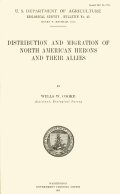
 |
|
Food Of Our More Important FlycatchersF.E.L. Beal
4 color and 1 b/w plates: Louis Agassiz Fuertes
Biological Survey Bulletin 44
US Department of Agriculture
Government Printing Office
1912
From the introduction: "The flycatchers for the most part inhabit the open country, and prefer to live about gardens, orchards, and sparsely timbered hill- sides. Several species are not averse to human neighbors and make their nests in the crannies of buildings, while a number of others build in covered sites, such as hollow trees, under bridges, or under the overhanging bank of a stream. Many of the species show a strong liking for the vicinity of water, and are frequently to be found in the neighborhood of streams or pools, and in dry parts of the country every watering trough by the roadside has its attendant flycatcher. This fondness for the vicinity of water doubtless arises from the fact that insects are abundant in such situations. Most of the species are migratory, though some of them within rather narrow limits. These birds are extremely agile upon the wing, and turn in the air with extraordinary facility, which enables them to catch the flying insects, of which their food largely consists. Their favorite method of feeding is to perch upon a post, stake, or leafless twig, and from tins outlook watch for their prey, and then to sally forth and snap the luckless insect in midair, often with a sharp click of the bill and a sudden turn back toward the perch."
|
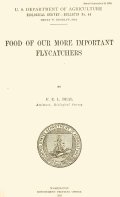
 |
|
Index To Papers Relating To The Food Of BirdsBy Members Of The Biological Survey In Publications Of The United States Department Of Agriculture, 1885-1911W.L. McAtee
Biological Survey Bulletin 43
US Department of Agriculture
Government Printing Office
1913
From the introduction: Since 1885 no fewer than 131 papers relating wholly or in part to the economic status of birds have appeared in the various publications of the department, including Annual Reports, Bulletins, Faunas, Yearbooks, Farmers' Bulletins, and Circulars. These contain more or less extended accounts of 401 species of native birds and 59 foreign or introduced species. The index serves the two very useful purposes: (1) Of showing just what has and what has not been published by the department on the status of birds in the United States; (2) of greatly facilitating reference to the data contained in the reports.
|
 |
|
Report Of An Expedition To Laysan Island In 1911Under The Joint Auspices Of The United States Department Of Agriculture And University Of IowaHomer R. Dill and W.M. Alanson Bryan
Photographs and a map
Biological Survey Bulletin 42
US Department of Agriculture
Government Printing Office
1912
From the introduction: The Hawaiian Islands Reservation is composed of the islands and reefs included in the leeward chain extending in a northwesterly direction from the main Hawaiian Group. These islands are situated from 100 to 300 miles apart and are composed principally of lava. Laysan, the largest island of the reservation, is low and flat, the highest point being only 50 feet above sea level. On the surface of this island is a layer of coral sand and phosphate rock. Laysan has an area of about 2 square miles; the others vary in size from 1 square mile to small rocky reefs. Bird Island is high and precipitous, having a peak of 903 feet, and one side of the island is perpendicular. These islands have a vegetation of low bushes and sand grasses. The climate is warm but not enervating, tempered as it is by the northeast trade winds. Severe thunder storms are almost unknown. At the present time the islands are entirely uninhabited by man, and indeed landing can be effected only in favorable weather; but they offer excellent nesting sites and abundant food for the millions of sea birds winch resort to this remote oceanic reservation.
|
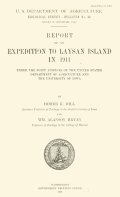
 |
|
Chronology And Index Of The More Important Events In American Game Protection, 1776-1911T.S. Palmer
Biological Survey Bulletin 41
US Department of Agriculture
Government Printing Office
1912
From the introduction: Requests are constantly received for information regarding various matters connected with the protection of game, and particularly as to the States which have adopted certain measures. From the information on file the following index has been prepared to answer such inquiries and also to make the facts more generally available.
|
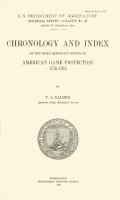 |
|
Report On Conditions Of Elk In Jackson Hole, Wyoming, In 1911Edward A. Preble
Biological Survey Bulletin 40
US Department of Agriculture
Government Printing Office
1911
From the introduction: At the last session of the sixty-first Congress an item was incorporated in the appropriation for the Biological Survey "for the feeding, protecting, and removal of elk in the country known as Jackson's Hole and vicinity, in the State of Wyoming." Steps were immediately taken to obtain the information necessary to enable the Biological Survey to undertake intelligently and effectively the solution of the elk problem in Wyoming.
|
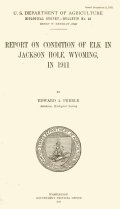 |
|
Woodpeckers In Relation To Trees And Wood ProductsW.L. McAtee
Color plates: Louis Agassiz Fuertes
Photographs and b/w illustrations
Biological Survey Bulletin 39
US Department of Agriculture
Government Printing Office
1911
From the introduction: Woodpeckers are peculiarly dependent upon trees, which furnish them food, shelter, and cradles for their young. No birds are more highly specialized nor more perfectly adapted to a particular mode of life than are most woodpeckers to arboreal existence. Moreover, as trees are important to woodpeckers, so are these birds important to trees. Woodpeckers benefit trees by consuming many of the most destructive forest pests, insects largely inaccessible to other birds. In securing these insects, however, which constitute the bulk of their food, and in making nests and shelter cavities, woodpeckers have another significant economic relation to trees, for they remove bark and wood from both dead and living trees. In the case of dead trees little or no harm is done. When, however, they make excavations in living trees, the birds destroy more or less of the cambium layer, from winch proceeds the growth of both wood and bark. Slight injuries to the cambium result in distorted growth, but the destruction of large areas may cause death. Since trees are exceedingly valuable to man, the habits of birds whose relations to trees are so vital are of much economic importance. It is the purpose of tins bulletin to examine the evidence for and against woodpeckers and to determine their status according to the effect of their habits upon trees and wood products. Injuries by woodpeckers are treated under two heads: (1) Damage by woodpeckers in general; (2) injuries due almost exclusively to the three species properly known as sapsuckers.
|
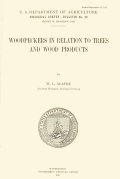

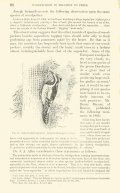 |
|
Birds Of ArkansasArthur H. Howell
4 b/w plates: Louis Agassiz Fuertes
B/W photographs and maps
Biological Survey Bulletin 38
US Department of Agriculture
Government Printing Office
1911
From the introduction: Arkansas, although long known as a paradise for sportsmen, has been strangely neglected by ornithologists. No detailed study of the avifauna of the State has hitherto been made and very little on its animal life has been published. In mapping the life zones of the Mississippi Valley the Biological Survey has been hampered by the lack of definite information on the distribution of birds in Arkansas, and in order to obtain the data necessary to complete its maps it was found necessary to make a special investigation of the birds of the State and to compile the published records. Arkansas is remarkable for the abundance and variety of its bird life, and many interesting problems of distribution are presented as a result of its topography and geographical position. Situated in the heart of the Mississippi Valley, it forms part of the great highway of migration for a large majority of the birds of passage which summer in the Northern States and Canada, while it affords a congenial winter resort for myriads of waterfowl and great numbers of the smaller land birds driven south by the severity of more northern climes.
|

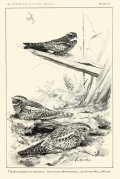
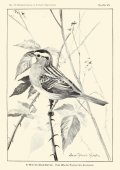 |
|
Food Of The Woodpeckers Of The United StatesF.E.L. Beal
5 color and 1 b/w plates: Louis Agassiz Fuertes
Biological Survey Bulletin 37
US Department of Agriculture
Government Printing Office
1911
From the introduction: Woodpeckers are essentially arboreal in their habits and obtain the greater part of their food from trees. Their physical con- formation eminently adapts them to this mode of life. Their legs are rather short and stout, and the toes are furnished with strong, sharp claws. With the exception of the genus Picoides, all North American woodpeckers have four toes, two of which point forward and two backward. To further aid in maintaining themselves on the trunks of trees, their tails are com- posed of stiff feathers terminating in sharp spines, which can be pressed against the bark and so serve as a prop to hold the bird in an upright position while it is at work. Woodpeckers are thus enabled to cling easily to the trunks and branches and to strike effective blows with their beaks upon the bark or wood As much of the food of woodpeckers is obtained from solid wood, Nature has provided most of them with a stout beak having a chisel shaped point, which forms an exceedingly effective wood-cutting instrument. But the most peculiar and interesting point in the anatomy of these birds is the tongue. This is more or less cylindrical in form and usually very long (fig. 1, a). At the anterior end it generally terminates in a hard point, with more or less barbs upon the sides (fig. 1b). Posteriorly the typical woodpecker tongue is extended in two long, slender filaments of the hyoid bone which curl up around the back of the skull and, while they commonly stop between the eyes, in some species they pass around the eye (fig. 2, b), but in others enter the right nasal opening and extend to the end of the beak (fig. 2, a). In this last case the tongue is practically twice the length of the head. Posteriorly this organ is inclosed in a muscular sheath by means of which it can be extruded from the mouth to a considerable length, and used as a most effective instrument for dislodging grubs or ants from their burrows in wood or bark. Hence, while most birds have to be content with such insects as they find on the surface or in open crevices, the woodpeckers devote their energies to those larvae or grubs which are beneath the bark or even in the heart of the tree. They locate their hidden prey with great accuracy and often cut small holes directly to the burrows of the grub.
|
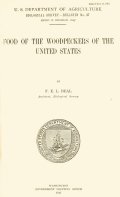

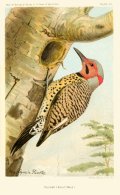 |
|
Raising Deer And Other Large Game Animals In The United StatesDavid E. Lantz
Biological Survey Bulletin 36
US Department of Agriculture
Government Printing Office
1910
From the introduction: In most parts of the country the number of game animals is steadily diminishing and game for table use has already become a high-priced luxury. Experiments have shown that some species, especially of the deer family, can be brought to a state of semi-domestication with comparative ease and can be bred and raised at very small cost. The chief purpose of the present bulletin is to call attention to the importance of raising elk and deer for venison, to indicate the particular species most readily reared in preserves, and to emphasize the importance of so modifying state game laws as to encourage the use of private effort and capital in making a marketable commodity of venison and placing it within the reach of people of moderate means.
|
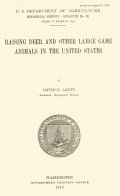 |
|
Distribution And Migration Of North American Shorebirds
Wells W. Cooke
4 b/w plates: Louis Agassiz Fuertes
Biological Survey Bulletin No. 35
US Department of Agriculture
Government Printing Office
1910
From the introduction: Shorebirds form a valuable national resource, and it is the plain duty of the present generation to pass on to posterity this asset undiminished in value. Consistent and intelligent legislation in favor of any group of birds must be founded on extended, accurate information, and must include knowledge of the breeding and distribution of the birds - where they spend the summer, whither they retire in winter, and when and by what routes they migrate. The present bulletin supplies this needed information so far as it is now available. Consideration of our shorebirds (Limicolae) from an economic point of view is recent. The early settlers found ducks, geese, and swans swarming in certain sections of the United States, and grouse and turkeys very abundant. The size and toothsomeness of these birds made them important objects of pursuit for food, while the shorebirds were considered unworthy of notice. As the great flocks of ducks and geese along the Atlantic coast diminished in numbers, the attention of gunners, especially of market hunters, was turned to the shorebirds, then in countless numbers. A generation of constant harassment spring and fall has almost exterminated some of the larger species and has very greatly reduced even the smaller ones. The time has come when this indiscriminate slaughter must cease if the present remnant of the shorebirds is to be preserved.
|
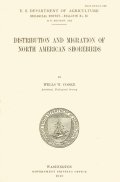
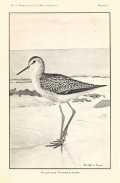
 |
|
Birds of California in Relation to the Fruit Industry, Part IIF.E.L. Beal
6 color plates: Louis Agassiz Fuertes
Biological Survey Bulletin 34
US Department of Agriculture
Government Printing Office
1910
From the introduction: The first part of the report on Birds of California in Relation to the Fruit Industry was published in 1907. In addition to the Linnet or house finch, which has attracted wide attention and is the subject of much complaint, 37 other species were discussed. In the present and concluding part, the food habits of 32 additional species are treated. Among them are some of the most important birds of the State, regarded from the standpoint of the farmer and fruit grower. The aim has been to collect all data possible on the food of the several species, to consider the facts impartially, and to render a just verdict as to the birds' economic relations. All the birds whose food habits are discussed have direct relations with husbandry. It is true that many of them have not been charged with the destruction or injury of fruit or any other farm products. Almost all however, destroy great numbers of harmful insects or devour seeds of noxious weeds; hence they are important economically.
|
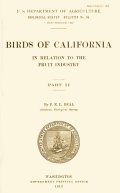
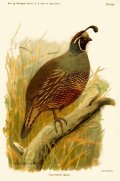
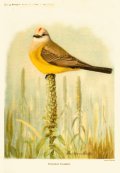 |
|
The Brown Rat In The United StatesDavid E. Lantz
Biological Survey Bulletin 33
US Department of Agriculture
Government Printing Office
1909
From the introduction: The futility of past efforts and the lack of permanent results indicate that the real cure for the rat evil in cities, especially seaports, lies in preventive rather than curative methods. The extraordinary success that has attended the rat's struggle for existence is to be explained largely by the abundance of food and shelter furnished by man. Preventive measures should be directed to withholding these advantages.
|
 |
|
Food Habits of the GrosbeaksW.L. McAtee
3 color plates: Louis Agassiz Fuertes
Numerous b/w illustrations
Biological Survey Bulletin 32
US Department of Agriculture
Government Printing Office
1908
From the introduction: Two distinct groups of finches or sparrows are commonly known as grosbeaks. One of these, which includes the pine and evening grosbeaks, is of little practical importance, since its members breed and pass most of their lives in mountainous regions, or in the northern parts of North America. The other group includes the cardinal, gray, rose-breasted, black-headed, and blue grosbeaks, which spend either the summer or the entire year within agricultural regions of the United States. Hence their food habits are of considerable importance to the farmer. The members of the first-named group may be dismissed with the statement that during the period when they occur in non-mountainous districts their food consists largely of wild seeds and berries. Apparently the best relished are those of mountain ash, choke cherry, box elder, white ash, and maple, and of spruce, red cedar, and other coniferous trees. The food habits of the second group are treated in detail in the following pages.
|
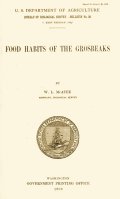

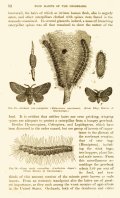 |
|
An Economic Study Of Field Mice (Genus Microtus)David E. Lantz
1 color and 3 b/w plates: Louis Agassiz Fuertes
Biological Survey Bulletin 31
US Department of Agriculture
Government Printing Office
1907
From the introduction: Field mice are so generally distributed throughout the United States and at times are so numerous in certain regions that they do serious damage to gardens, nurseries, orchards, and forests. The several species therefore possess an economic importance quite out of proportion to their size. The present bulletin gives a concise account of their distribution and general habits, the nature of the damage they do, together with methods of prevention, the best means of limiting their increase under ordinary circumstances, and of reducing their numbers when, by reason of excessive multiplication, the injuries they inflict are serious.
|
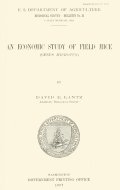 |
|
Birds of California in Relation to the Fruit Industry, Part IF.E.L. Beal
1 color and 3 b/w plates: Louis Agassiz Fuertes
Biological Survey Bulletin 30
US Department of Agriculture
Government Printing Office
1907
From the introduction: In response to numerous complaints from fruit growers concerning depredations by birds in orchards and vineyards in the Pacific coast region, investigation of the subject was undertaken by the Biological Survey several years ago. In conducting this investigation the writer spent about nineteen months in California, including the fruit seasons of 1901, 1903, and 1906, during which time he visited the most important fruit-growing regions of the State, inspected hundreds of orchards, and interviewed many fruit growers. Kindness and courtesy were everywhere met with, and every facility was tended by orchardists for the acquisition of information, even to a suspension of the customary rule with regard to trespass and shoot on private grounds. In addition to the knowledge gained by field observations, stomachs of all the species of Pacific coast birds economically valuable have been collected, examined, and their contents recorded. When depredations are so widespread and involve so many different species of birds, a thorough knowledge of the nature and extent of the damage done and of the attending circumstances is of great importance.
|
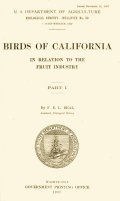
 |
|
The Relation Of Birds To The Cotton Boll Weevil
Arthur H. Howell
Color frontispiece: Bruce Horsfall
Line drawings in text: J.L. Ridgway and possibly others
Biological Survey Bulletin No. 29
U.S. Department of Agriculture
Government Printing Office
1907
From the introduction: In view of the rapid spread of the cotton boll weevil in the Southern States and the enormous damage to the cotton crop through its ravages, a study of the relations of our native birds to the pest is of increasing importance. Investigation of the problem during several seasons has shown that while birds can not be depended upon to stay its progress, much less to exterminate it, yet the service they render in controlling it is of great importance. It has been discovered that several species of birds eat great numbers of the pest and among the weevil-eating kinds are a few whose numbers it is believed can be greatly augmented through careful protection and by providing them with safe nesting places. The relation of birds to the boll weevil has been studied by the Biological Survey during portions of four seasons, and by the Bureau of Entomology during portions of two seasons. Seventeen species of birds were examined during the seasons of 1903 and 1904 by the Bureau of Entomology, with the result that 11 species were found to feed on the weevil.
|
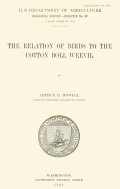

 |
|
Game Commissions And Wardens: Their Appointment, Powers And Duties
R.W. Williams Jr
Biological Survey Bulletin No. 28
U.S. Department of Agriculture
Government Printing Office
1907
From the introduction: As indicated by its title, this bulletin is restricted to the appointment, powers, and duties of State officers, and does not consider the enforcement of Federal laws or regulations of any kind. The report has been divided into three parts, as follows: Part I consists of a general discussion of the office and duties of wardens; Part II is a condensed summary of the provisions of game laws relating to enforcement; and Part III contains the full text of such laws.
|
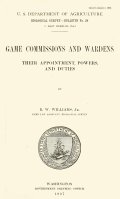 |
|
The North American Eagles And Their Economic Relations
Harry C. Oberholser
Two b/w plates: R. Ridgway
Biological Survey Bulletin No. 27
U.S. Department of Agriculture
Government Printing Office
1906
From the introduction: The present purpose is to bring together such facts as have bearing on the economic relations of the North American eagles; and this bulletin has therefore to do with the distribution of the several species, their general manner of life, as well as, most important of all, their food habits. It is difficult to obtain stomachs of eagles for examination, hence few data of this kind have been available at first hand; but all other sources of information have been utilized in order that this report may represent as nearly as possible our present knowledge of the subject.
|
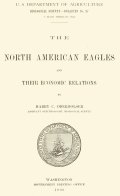
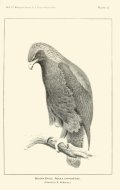 |
|
Distribution And Migration Of North American Ducks, Geese, And Swans
Wells W. Cooke
Biological Survey Bulletin No. 26
U.S. Department of Agriculture
Government Printing Office
1906
From the introduction: "Wild fowl are distributed over the whole world. From time immemorial ducks, geese, and swans have been held in high esteem by mankind, and everywhere they have been eagerly pursued for sport or for food. Passing by the purely aesthetic value of the birds as beautiful and welcome denizens of our waters and as lending the charm of life and animation to our otherwise desolate ponds and lakes; passing by, too, their importance to thousands of men who are lured from business cares to pursue them and who derive from their pursuit both health and pleasure, their economic value and importance as food are very great. The flesh not only is palatable and nutritious, but is so different from that of domestic fowls as to form a most welcome addition to the table both of the rich and the poor.
|

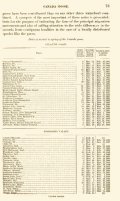 |
|
Birds That Eat The Cotton Boll Weevil: A Report Of Progress
Arthur H. Howell
Division Of Biological Survey Bulletin No. 25
US Department of Agriculture
Government Printing Office
1906
From the introduction: As a result of work in 1905 our knowledge of the part birds play in the destruction of the pest has been considerably extended, and several additions have been made to the list of species known to prey upon the boll weevil. The protection of these by law is earnestly recom- mended.
|
 |
|
The Grouse And Wild Turkeys Of The United States, And Their Economic Value
Sylvester D. Judd
Color frontispiece and 1 b/w plate: Louis Agassiz Fuertes
Division Of Biological Survey Bulletin No. 24
US Department of Agriculture
Government Printing Office
1905
From the introduction: From the earliest settlement of the country to the present time these game birds have been of great economic consequence. Their value as food was early recognized, and they played an important role by furnishing the pioneers with no small part of their fare. When found by the Spaniards domesticated among the Indians of Mexico, the importance of the turkey was at once perceived, and the bird was soon carried all over the world. It is only in comparatively recent times, how- ever, that the economic value of grouse and turkeys as insect destroyers has been recognized. The results of the present investigations should lead to a wider knowledge of the essential part these birds play in checking the increase of noxious weeds and insects and the importance of preserving them and of increasing their numbers.
|

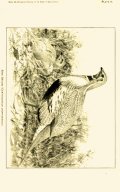 |
|
The Horned Larks And Their Relation To Agriculture
W.L. McAtee
B/W frontispiece and line drawings in text
Division Of Biological Survey Bulletin No. 23
US Department of Agriculture
Government Printing Office
1905
From the introduction: The horned larks are small but hardy birds which frequent the open country and never live in forests. They are found in a great variety of situations, and feed along roads, in weedy or freshly plowed fields, on commons or other waste places, and in closely grazed pastures, meadows, and stubble fields. The beaches and salt marshes of the coasts, the lake shores, muddy flats, and swamps of the interior are thronged with them in fall and winter. In the far West they live in hot desert valleys, on arid table-lands, on level grassy prairies, in the foothills, and even on bare mountain peaks. They are readily distinguished from other small ground-loving birds. They are about the size of the bluebird, their throats are white or yellow, there is a conspicuous black mark across the breast, and just above and behind the eyes are small pointed tufts of dark-colored feathers which are often erected. These black tufts or horns are perhaps the bird's most characteristic feature, and give origin to the common name 'horned lark,' by which it is known over most of the United States.
|


 |
|
Birds Known To Eat The Boll Weevil
Vernon Bailey
Division Of Biological Survey Bulletin No. 22
US Department of Agriculture
Government Printing Office
1905
From the introduction: The relation of birds to the boll weevil and the extent of dependence that can be placed upon the former in limiting its inroads are not well understood. As requests from the cotton districts for information upon the subject have been many and urgent, field investigations, of which the present bulletin is the first outcome, are now being conducted by the Biological Survey, with a view to ascertaining the particular birds which perform the most important service in preying upon the weevil, to the end that special protection be extended to such species.
|
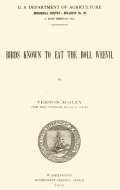 |
|
The Bobwhite And Other Quails Of The United States In Their Economic Relations
Sylvester D. Judd
Color frontispiece and 1 b/w plate: Louis Agassiz Fuertes
Division Of Biological Survey Bulletin No. 21
US Department of Agriculture
Government Printing Office
1905
From the introduction: The quails of the United States, because of their interesting habits and marvelous diversity of form and color, are a notably attractive group. All are handsome birds, but the most striking and beautiful species live in the Southwest and on the Pacific coast. Seven species occur within our borders, but only one in the Eastern States. The others are widely distributed from Texas to California and Oregon. Their range was, and still is, continuous along the entire southern border of the country from the Atlantic to the Pacific; but there is an irregular belt along the northern border and a large area in the interior, comprising the Great Plains, the northern three- fourths of the Great Basin,- and the Rocky Mountains, in which they appear to have been originally wanting. With few exceptions our quails welcome the extension of agriculture, and the added food supply in farmed areas results in an increase of their numbers. This is equally true of the bobwhite of the East, and of some of the desert species of the West. So fully does the bobwhite appreciate the advantages of the farm that its range has increased with the extension of the cultivated area, especially west of the Mississippi.
|

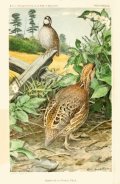
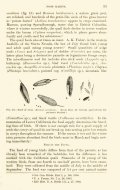 |
|
Coyotes In Their Economic Relations
David E. Lantz
Division Of Biological Survey Bulletin No. 20
US Department of Agriculture
Government Printing Office
1905
From the preface: The subject is of immediate importance to the sheep industry of the West, where the wasteful method of sheep herding prevails. If in the range country sheep can be fenced with coyote-proof fencing at moderate cost, as seems probable, herding may be done away with and the sus- taining capacity of the lands thereby greatly increased.
|
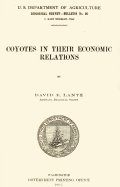
|
|
Hunting Licenses: Their History, Objects, And Limitations
T.S. Palmer and H.W. Olds
Division Of Biological Survey Bulletin No. 19
US Department of Agriculture
Government Printing Office
1904
From the preface: The object of this bulletin is to render generally accessible the information collected by the Department on the subject of resident and nonresident licenses. In States which have adopted the license system statistics regarding hunting not previously collected are now available. Thus the figures here presented show that during 1903 the receipts from licenses exceeded $10,000 in each of 9 States, and Illinois and Wisconsin each collected nearly $100,000; the total number of hunters in 10 States which license both residents and nonresidents exceeded 261,000; and the States which attracted most nonresident hunters were Maine, North Carolina, and Wisconsin.
|
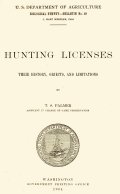
|
|
Distribution And Migration Of North American Warblers
Wells W. Cooke
Division Of Biological Survey Bulletin No. 18
US Department of Agriculture
Government Printing Office
1904
From the introduction: The warblers are birds of wide distribution. They occur in summer in greater or less abundance over nearly the whole of North America except the arid lands of the Southwest and the Barren Grounds of the far North. Though of small size they are brightly colored, and during the migrations they come in such numbers, both of species and individuals, that they often form the most conspicuous part of a bird wave, and their return is awaited with eagerness by students of migration. In spring the lover of the beautiful finds among them brilliant colors in multiple variety; the practiced ear is taxed to distinguish their faint songs dropping from the tree tops; and the experienced ornithologist feels a pleasurable excitement in scanning each individual of the passing host as he seeks the rarity that will more than repay the time spent in the search.
|
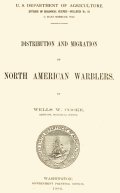
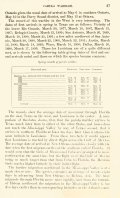 |
|
Birds Of A Maryland Farm: A Local Study Of Economic Ornithology
Sylvester D. Judd
Illustrations: J.L. Ridgway and others
B/W photographs
Division Of Biological Survey Bulletin No. 17
US Department of Agriculture
Government Printing Office
1902
From the introduction: With a view to ascertaining how far local conditions might modify the details of general conclusions based on data from widely separated regions, a study of the food habits of the birds on a particular farm was undertaken. From July 30, 1895, to July 24, 1902, visits were made at frequent intervals and including every month of the year except January. To obtain an idea of the available food supply, the insects, berries, and seeds found on the place were collected; the condition of the crops and the insects infesting them were noted; detailed observations of the birds' food habits were made in the field, and the stomachs of 698 birds were collected and examined, 53 being those of English sparrows and the remainder (615) those of native species.
|
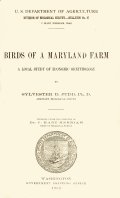
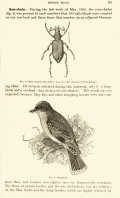 |
|
Digest Of Game Laws For 1901
T.S. Palmer and H.W. Olds
Division Of Biological Survey Bulletin No. 16
US Department of Agriculture
Government Printing Office
1901
From the preface: The object of this report is to present in convenient form the provisions of the laws now in force, including the amendments enacted during the present year. In view of the fact that the game season opens in several States on September 1, it is desirable that this bulletin be published and distributed as promptly as possible.
|
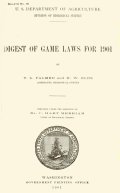
|
|
The Relation of Sparrows to Agriculture
Sylvester D. Judd
Illustrations: J.L. Ridgway and others
Division Of Biological Survey Bulletin No. 15
US Department of Agriculture
Government Printing Office
1901
From the introduction: Sparrows are well known, and have figured frequently in ornithological literature, but the position they occupy in relation to agriculture has heretofore received only casual consideration. It is evident that a group of birds so abundant, so widely distributed, and in such constant association with farms and gardens must play an important part in rural economy, and that a thorough investigation of their food habits should be useful. The results of such an investigation are embodied in the present paper and amply demonstrate the value of these birds to the agriculturist - a value greater than that of any other group of birds whose economic status has thus far been investigated. The native sparrows contrast markedly in this respect with the introduced English sparrow, the pernicious habits of which have formed the subject of a special report, and are briefly treated in this bulletin for purposes of comparison (see p. 92). This naturalized sparrow is a pest wherever it is found, while the native sparrows are well worthy of protection and encouragement.
|
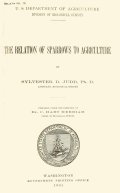
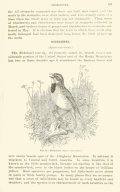 |
|
Laws Regulating The Transportation And Sale Of Game
T.S. Palmer and H.W. Olds
Illustrations: J.L. Ridgway
Division Of Biological Survey Bulletin No. 14
US Department of Agriculture
Government Printing Office
1900
From the preface: The object of this report is to present in convenient form a digest of the State laws now in force which affect the trade in game. In view of the fact that the open season is at its height, and that considerable quantities of game are now being shipped to market, it is very desirable that this bulletin be published and distributed as promptly as possible.
|
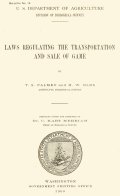
|
|
Food Of The Bobolink, Blackbirds, And Grackles
F.E.L. Beal
Illustrations: J.L. Ridgway
Division Of Biological Survey Bulletin No. 13
US Department of Agriculture
Government Printing Office
1900
From the introduction: In this bulletin are discussed the food habits of the bobolink, the cowbird, the yellow-headed blackbird, the red-winged blackbird, the California red- winged blackbird, the rusty blackbird, Brewer's black- bird, the crow blackbird, and the boat-tailed grackle. These comprise all the important members of the group with the exception of the meadowlarks and orioles. 1 One or more of these species may be found at some time of the year in every State and Territory. As they are much given to nesting and feeding about farms and stock yards or to visiting outlying grainfields and pastures, the character of their food becomes a question of considerable importance to the cultivator.
|
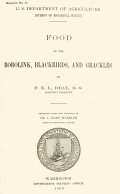
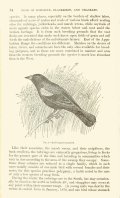 |
|
Legislation For The Protection Of Birds Other Than Game Birds
T.S. Palmer
Illustrations: J.L. Ridgway
Division Of Biological Survey Bulletin No. 12
US Department of Agriculture
Government Printing Office
1900
From the preface: It is generally admitted that birds which are neither fit for food nor injurious to crops, and more especially species which are insectivorous, are entitled to protection, but the laws enacted for their preservation lack uniformity, and many useful species are not now protected. Fully 90 percent of existing bird legislation has been enacted for the benefit of game birds, which comprise less than 20 percent of all the birds of North America. The other species, which are of special interest to the farmer and the general public, have, until recent years, received scant protection. It is the legislation affecting this large group (more than 80 percent of the species on the Continent) which forms the subject of the present bulletin.
|
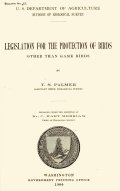
 |
|
The Geographic Distribution Of Cereals In North America
C.S. Plumb
Division Of Biological Survey Bulletin No. 11
US Department of Agriculture
Government Printing Office
1898
From the introduction: The object of the inquiry was to ascertain the areas in which the more important varieties of certain cereals were cultivated and to determine how far the distribution of cereals accords with the boundaries of the life zones as mapped by the Biological Survey.
|
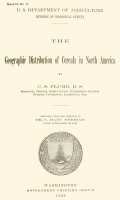 |
|
Life Zones And Crop Zones Of The United States
C. Hart Merriam
Division Of Biological Survey Bulletin No. 10
US Department of Agriculture
Government Printing Office
1898
From the introduction: For ten years the Biological Survey (and its predecessor, the Division of Ornithology and Mammalogy) has had small parties in the field traversing the public domain for the purpose of studying the geographic distribution of our native land animals and plants and mapping the boundaries of the areas they inhabit, The present, report is intended to explain the relations of this work to practical agriculture and to show the results thus far attained - it does not deal with other investigations carried on by the Survey.
|
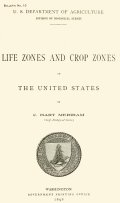 |
|
Cuckoos And Shrikes In Relation To Agriculture
The Food Of Cuckoos: F.E.L. Beal
The Food Of Shrikes: Sylvester D. Judd
Illustrations: J.L. Ridgway
Division Of Ornithology And Mammology Bulletin No. 9
US Department of Agriculture
Government Printing Office
1898
From the opening lines of the Shrikes section: Two species of shrikes inhabit North America. One, the loggerhead shrike (Lanius ludovicianus et subspec), is a permanent resident in the United States; the other, the butcherbird [Lanius borealis), visits us from the north in winter. Either might be mistaken for a mocking bird, but upon close inspection is seen to have the hooked beak of a hawk; instead of possessing talons, however, it has weak and slender feet, thus combining characters of a bird of prey with those of a song bird. During cold weather the shrike in wait for prey takes his stand on some high perch that commands a wide view. In this position he watches, ready to pounce on the first bird that twitters in the briers, or mouse that rustles in the grass. When the quarry has been secured, it is carried to a sharp twig or thorn and spitted, and then the hunter, ever eager to satisfy its desire for the chase, goes off to the hedgerows to search for more game.
|

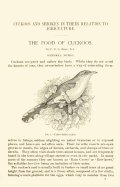 |
|
The Jack Rabbits Of The United StatesT.S. Palmer
Division Of Ornithology And Mammology Bulletin No. 8
US Department of Agriculture
Government Printing Office
1896
From the preface: The damage done to crops by rabbits has been illustrated very forcibly during recent years by the losses sustained by farmers and orchardists m the arid regions of the West through the depredations of the large native hares, or jack rabbits. The introduction of irrigation and the cultivation of large tracts of land have favored the increase of rabbits in several States by furnishing a new source of food supply. To such an extent have their depredations increased that the extermination of jack rabbits has become a serious question in California, Colorado, Idaho, Oregon, and Utah.
|

|
|
The Common Crow Of The United StatesF.E.L. Beal
The Tongues Of Woodpeckers: F.A. Lucas
Illustrations: J.L. Ridgway
Division Of Ornithology And Mammology Bulletin No. 7
US Department of Agriculture
Government Printing Office
1895
From the general remarks: With the possible exception of the crow, no birds are subject to more adverse criticism than woodpeckers. Usually no attempt is made to discriminate between the numerous species, and little account is taken of the good they do in destroying injurious insects. The name Sapsucker has been applied to two or three of the smaller kinds, in the belief that they subsist to a great extent upon the juices of trees, obtained from the small holes they make in the bark. There can be little doubt that one species, the Yellow-bellied Woodpecker (Sphyraincus varius), does live to a considerable extent upon this sap. Observation does not show that other species have the same habit, but it is a difficult point to decide by dissection, as fluid contents disappear quickly from the stomach. Many observers have testified to the good work these birds do in destroying insects, while others have spoken of harm done to fruit or grain. Both are correct within certain limits.
|
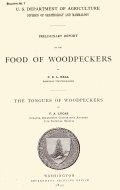
 |
|
The Common Crow Of The United StatesWalter B. Barrows and E. A. Schwarz
Division Of Ornithology And Mammology Bulletin No. 6
US Department of Agriculture
Government Printing Office
1895
From the opening lines: The Common Crow is generally distributed from the southern border of the United States north to about latitude 03°. It is abundant in the well-watered regions of the East, but in the West it is rare or local in the arid country, which comprises most parts of the Great Plains, the Great Basin, and the deserts of the Southwest from Texas to California. In southern Florida the Common Crow differs slightly from the northern bird, and is known as the Florida Crow. Four other crows and ravens are found in the United States. Along the Atlantic Coast from Long Island southward the small Fish Crow (Corvus ossifragus) occurs with the Common Crow, while on the Pacific Coast from Washington northward the Northwest Crow (Corvus caurinus) is found. The Eaven (Corvus corax sinuatus) inhabits various parts of the United States. The White-necked Raven (Corvus cryptoleucus) is common locally in Arizona, New Mexico, and some other parts of the Southwest.
|

 |
|
The Pocket Gophers Of The United StatesVernon Bailey
Division Of Ornithology And Mammology Bulletin No. 5
US Department of Agriculture
Government Printing Office
1895
From the introduction: The aim of the present bulletin is to give a popular account of the Pocket Gophers of the United States.
|
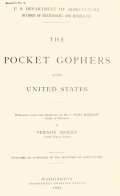
|
|
The Prairie Ground Squirrels Or Spermophiles Of The Mississippi ValleyVernon Bailey
Color plates: Ernest L. Thompson
Division Of Ornithology And Mammology Bulletin No. 4
US Department of Agriculture
Government Printing Office
1893
From the introduction: The object of the present bulletin is to describe the haunts and habits of the five species inhabiting the Mississippi Valley region, and to summarize the remedies that have been used with greatest success in holding their numbers in check.
|
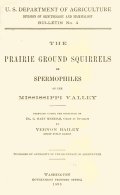
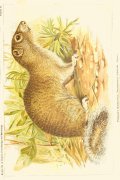
|
|
The Hawks And Owls Of The United States In Their Relation To AgricultureA.K. Fisher
Color plates: J.L. Ridgway, R. Ridgway
Division Of Ornithology And Mammology Bulletin No. 3
US Department of Agriculture
Government Printing Office
1893
From the prefatory letter: The statements herein contained respecting the food of the various hawks and owls are based on the critical examination, by scientific experts, of the actual contents of about 2,700 stomachs of these birds, and consequently may be fairly regarded as a truthful showing of the normal food of each species. The result proves that a class of birds commonly looked upon as enemies to the farmer, and indiscriminately destroyed whenever occasion offers, really rank among his best friends, and with few exceptions should be preserved, and encouraged to take up their abode in the neighborhood of his home. Only six of the 73 species and subspecies of hawks and owls of the United States are injurious. Of these, three are so extremely rare they need hardly be considered, and another (the Fish Hawk) is only indirectly injurious, leaving but two (the Sharp-shinned and Cooper's Hawks) that really need be taken into account as enemies to agriculture. Omitting the six species that feed largely on poultry and game, 2,212 stomachs were examined, of which 56 per cent contained mice and other small mammals, 27 per cent insects, and only 3 per cent poultry or game birds. In view of these facts the folly of offering bounties for the destruction of hawks and owls, as has been done by several States, becomes apparent, and the importance of an accurate knowledge of the economic status of our common birds and mammals is overwhelmingly demonstrated.
|
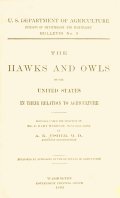


|
|
The English Sparrow (Passer domesticus) In North America Especially In Its Relations To AgricultureWalter B. Barrows
Division Of Economic Ornithology And Mammology Bulletin No. 1
US Department of Agriculture
Government Printing Office
1889
From the prefatory letter: The English Sparrow question in North America has grown to be a serious problem in economic science, particularly so far as the agricultural interests of the country are concerned - and the term agriculture must be here understood in its broadest and most comprehensive sense as including the grain-growing industries, truck-gardening, fruit-growing, the cultivation of flowers and ornamental shrubs and vines, and even forestry. It was deemed proper, therefore, that this question should be made the subject of the first bulletin of the newly established Division of Economic Ornithology and Mammalogy. The information necessary to a complete understanding of the subject has been collected with great care; the evidence submitted has been honestly weighed, and the results impartially stated.
|
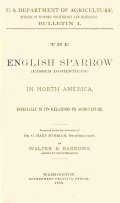 |
|
Report On Bird Migration In The Mississippi Valley In The Years 1884 And 1885W.W. Cooke
Division Of Economic Ornithology Bulletin No. 2
US Department of Agriculture
Government Printing Office
1888
From the prefatory letter: The present report, which has been prepared by Prof. W. W. Cooke, with the assistance of Mr. Otto Widinann and Prof. D. E. Lantz, is the first fruit of the co-operative labors of the Division of Economic Ornithology of the Department of Agriculture and the Committee on Bird Migration of the American Ornithologists' Union. It consists of two parts: (1) an introductory portion treating of the history and methods of the work, together with a general study of the subject of Bird Migration, including the influence of the weather upon the movements of birds, the progression of bird waves and causes affecting the same, the influence of topography and altitude upon migration, and the rates of flight in the various species; and (2) a systematic portion in which the five hundred and sixty species of birds known to occur in the Mississippi Valley are treated serially, the movements of each during the seasons of 1884 and 1885 being traced with as much exactness as the records furnished by the one hundred and seventy observers in the district permit.
|

 |
|